Black-bellied Slender Salamander -
Batrachoseps nigriventris
Cope, 1869
Description • Taxonomy • Species Description • Scientific Name • Alt. Names • Similar Herps • References • Conservation Status
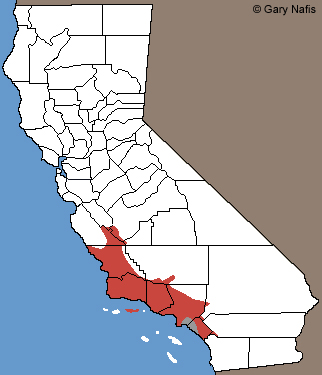 Red and possibly Gray: Range in California
Red and possibly Gray: Range in California
Range Map of all Slender Salamanders in California
Click on the map for a topographical view
Map with California County Names
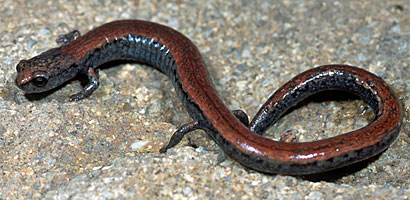 |
 |
||||||||||||||||||||||||||||||||||||||||||||||||||
| Adult, San Luis Obispo County | Adult, San Luis Obispo County | ||||||||||||||||||||||||||||||||||||||||||||||||||
 |
 |
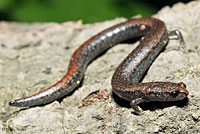 |
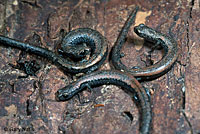 |
||||||||||||||||||||||||||||||||||||||||||||||||
| Adult, San Luis Obispo County | Adult, San Gabriel Mountains, Los Angeles County |
Sub-adult, 1400 ft., San Gabriel Mountains, Los Angeles County | Adults, 3,800 ft. San Gabriel Mountains, Los Angeles County | ||||||||||||||||||||||||||||||||||||||||||||||||
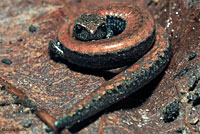 |
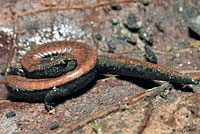 |
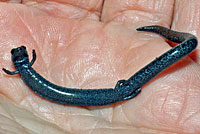 |
 |
||||||||||||||||||||||||||||||||||||||||||||||||
| Adult, 3,000 ft. San Gabriel Mountains, Los Angeles County | Underside of Sub-adult, 1400 ft., San Gabriel Mountains, Los Angeles County | Underside of adult , San Luis Obispo County |
|||||||||||||||||||||||||||||||||||||||||||||||||
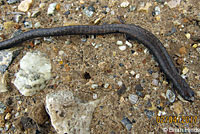 |
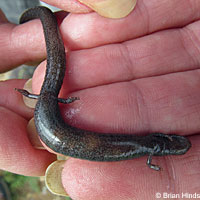 |
 |
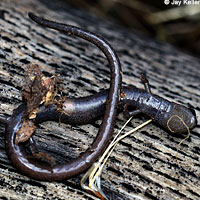 |
||||||||||||||||||||||||||||||||||||||||||||||||
| Adult found on the Palos Verdes Peninsula, L.A. County © Brian Hinds | Adult, Santa Ana Mountains, Orange County © Jay Keller |
Underside of adult, Santa Ana Mountains, Orange County © Jay Keller | |||||||||||||||||||||||||||||||||||||||||||||||||
 |
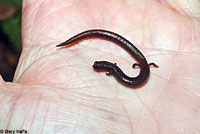 |
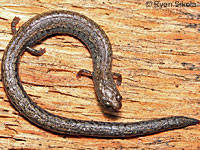 |
 |
||||||||||||||||||||||||||||||||||||||||||||||||
| Adult and Juvenile, Santa Barbara County |
Sub-adult, 1400 ft., San Gabriel Mountains, Los Angeles County | Adult, San Luis Obispo County © Ryan Sikola |
Adult, San Luis Obispo County © Ryan Sikola |
||||||||||||||||||||||||||||||||||||||||||||||||
 |
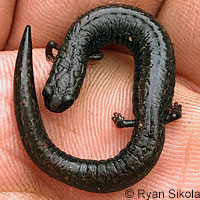 |
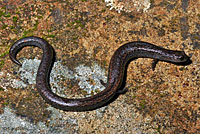 |
 |
||||||||||||||||||||||||||||||||||||||||||||||||
| Adult, coastal Southern California © Ivan Vershynin |
Adult, San Luis Obispo County © Ryan Sikola |
Adult, San Luis Obispo County | Adult out on the crawl near the edge of a creek in Santa Barbara County © Max Roberts |
||||||||||||||||||||||||||||||||||||||||||||||||
| Santa Cruz Island Population | |||||||||||||||||||||||||||||||||||||||||||||||||||
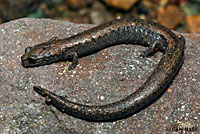 |
 |
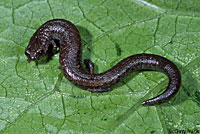 |
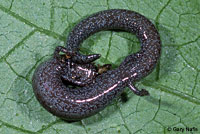 |
||||||||||||||||||||||||||||||||||||||||||||||||
| Adult, Santa Cruz Island, Santa Barbara County | Adult, Santa Cruz Island, Santa Barbara County | ||||||||||||||||||||||||||||||||||||||||||||||||||
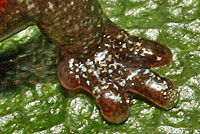 |
|||||||||||||||||||||||||||||||||||||||||||||||||||
| Slender Salamanders (genus Batrachoseps) have only 4 toes on their hind feet. All other California salamanders have 5 toes on their hind feet. | |||||||||||||||||||||||||||||||||||||||||||||||||||
Comparisons With Similar Sympatric Slender Salamander Species |
|||||||||||||||||||||||||||||||||||||||||||||||||||
| B. nigriventris B. major |
|||||||||||||||||||||||||||||||||||||||||||||||||||
| Coexists with B. major - Garden Slender Salamander, in some mountains in Los Angeles and Orange counties. Ongoing surveys have found that both species occur throughout most of the L.A. Basin, as well as in the mountains and foothills. B. major is the larger, more robust, of the two species, with longer limbs and a broader neck and head. It can be difficult to identify these two species where they both are found because it is hard to tell them apart unless they are side by side and that is not often possible. You can't tell just by the size or the body color alone. Both species are about the same size, and both have similar color variations. The best way to determine the species is to look at the color of the salamander's underside. (Go to this page for more information about how to differentiate a Black-bellied Slender Salamander from a Garden Slender Salamander.) If you find a salamander in L.A. or Orange Counties, it could be either species. (If you find it high up in the San Gabriel Mountains, look here.) If you find a Black-bellied Slender Salamander in one of these counties, it will be helpful to those who are tracking their range in the area if you take some pictures and then report your observation at H.E.R.P. and iNaturalist. People there will also help you to confirm your ID as long as you photograph the underside. |
|||||||||||||||||||||||||||||||||||||||||||||||||||
 |
 |
 |
|||||||||||||||||||||||||||||||||||||||||||||||||
| Top: B. nigriventris Bottom: B. major Note the larger body, legs, and toes of B. major. It can be difficult to identify these two species where they both are found because it is hard to tell them apart unless they are side by side and that is not often possible. You can't always tell just by the body color alone. The best way to determine the species is to look at the coloring of the underside. (See pictures to the right.) |
Left: B. nigriventris Right: B. major Comparison of the undersides of both species. B. nigriventris is dark in color on the belly and under the tail. B. major is light gray under the tail and throat and not as dark on the belly. |
||||||||||||||||||||||||||||||||||||||||||||||||||
 |
|||||||||||||||||||||||||||||||||||||||||||||||||||
| Left: B. major Right: B. nigriventris Both from Los Angeles County © Max Roberts |
|||||||||||||||||||||||||||||||||||||||||||||||||||
| B. nigriventris B. minor |
|||||||||||||||||||||||||||||||||||||||||||||||||||
| Coexists with B. minor - Lesser Slender Salamander, in the Coast Range. B. minor is distinguished by its more robust body, broader head and longer and larger limbs with more conspicuous toes than B. nigriventris. |
|||||||||||||||||||||||||||||||||||||||||||||||||||
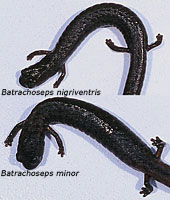 |
 |
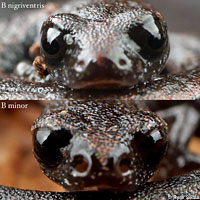 |
|||||||||||||||||||||||||||||||||||||||||||||||||
| Top: B. nigriventris Bottom: B. minor B. minor occurs entirely within the range of B.nigriventris. It is shown here with a small adult specimen of B. nigriventris that was found outside of the range of B. minor. B minor has distinctly larger hands and feet. |
Top: B. nigriventris Bottom: B. minor This comparison shows the different head and face shapes of adults of the two species. B. minor has a distinctly broader head with more prominent eyes. © Ryan Sikola |
Top: B. nigriventris Bottom: B. minor This comparison shows the different head and face shapes of yearling juveniles of the two species. © Ryan Sikola |
|||||||||||||||||||||||||||||||||||||||||||||||||
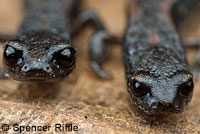 |
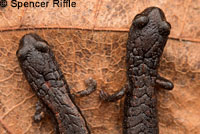 |
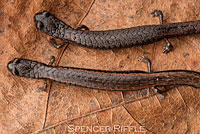 |
|||||||||||||||||||||||||||||||||||||||||||||||||
| Left: B. minor Right: B. nigriventris |
Left: B. nigriventris Right: B. minor |
Top: B. minor Bottom: B. nigriventris |
|||||||||||||||||||||||||||||||||||||||||||||||||
| Comparison of two salamanders found under same log in San Luis Obispo County © Spencer Riffle |
|||||||||||||||||||||||||||||||||||||||||||||||||||
| B. nigriventris B. incognitus |
|||||||||||||||||||||||||||||||||||||||||||||||||||
| Coexists with B. incognitus - San Simeon Slender Salamander, in some areas of northern San Luis Obispo County. B. incognitus is the larger, more robust, of the two species, with longer limbs and a broader neck and head than B. nigriventris. The digits of the toes of B. incognitus are individually distinct, and easier to see when compared to B. nigriventris which has smaller digits. |
|||||||||||||||||||||||||||||||||||||||||||||||||||
 |
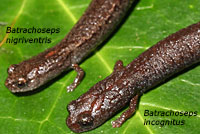 |
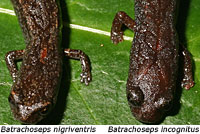 |
|||||||||||||||||||||||||||||||||||||||||||||||||
| Top: B. incognitus - San Simeon Slender Salamander Bottom: B. nigriventris B. incognitus has slightly larger legs and toes and neck. |
Left: B. nigriventris Right: B. incognitus - San Simeon Slender Salamander B. incognitus has slightly larger legs and toes and neck. |
||||||||||||||||||||||||||||||||||||||||||||||||||
| B. nigriventris B. gabrieli |
|||||||||||||||||||||||||||||||||||||||||||||||||||
| Coexists with B. gabrieli - San Gabriel Mountains Slender Salamander, at some localities in the San Gabriel Mountains. B. nigriventris has a narrower head, shorter limbs, smaller feet, longer tail. More Information. |
|||||||||||||||||||||||||||||||||||||||||||||||||||
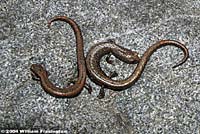 |
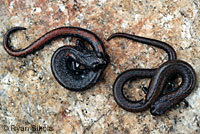 |
||||||||||||||||||||||||||||||||||||||||||||||||||
| Left: B. nigriventris Right: B. gabrieli - San Gabriel Mountains Slender Salamander The two species coexist at some locations in Los Angeles County. These two were found sheltering next to each other. Note the larger more robust limbs and body of B. gabrieli. © William Flaxington |
Left: B. gabrieli - San Gabriel Mountains Slender Salamander Right: B. nigriventris L. A. County © Ryan Sikola |
||||||||||||||||||||||||||||||||||||||||||||||||||
| B. nigriventris B. stebbinsi |
|||||||||||||||||||||||||||||||||||||||||||||||||||
| Coexists with B. stebbinsi - Tehachapi Slender Salamander, at several locations in the Tehachapi Mountains. B. stebbinsi can be distinguished by its more robust body with longer legs, largeer feet, distinct toes, and broader head. |
|||||||||||||||||||||||||||||||||||||||||||||||||||
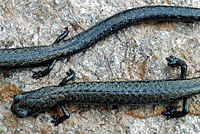 |
|||||||||||||||||||||||||||||||||||||||||||||||||||
| Top: B. nigriventris Bottom: B stebbinsi - Tehachapi Slender Salamander These species coexist in a small area in the Ft. Tejon area and the Tehachapi Mountains. These two salamaders were found together under the same rock. The B. stebbinsi here is a bit shorter than the B. nigriventris, but note the much larger legs and toes of B. stebbinsi. |
|||||||||||||||||||||||||||||||||||||||||||||||||||
| B. nigriventris B. gavilanensis |
|||||||||||||||||||||||||||||||||||||||||||||||||||
| Coexists with B. gavilanensis - Gabilan Mountains Slender Salamander, in the southern part of the range of B. gavilanensis. B. gavilanensis is the larger, more robust, of the two species, with longer limbs and a broader neck and head than B. nigriventris. |
|||||||||||||||||||||||||||||||||||||||||||||||||||
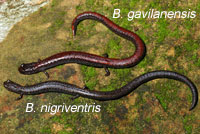 |
|||||||||||||||||||||||||||||||||||||||||||||||||||
| Top: B. gavilanensis - Gabilan Mountains Slender Salamander Bottom: B. nigriventris The ranges of these species overlap in some areas. |
|||||||||||||||||||||||||||||||||||||||||||||||||||
| B. nigriventris B. pacificus |
|||||||||||||||||||||||||||||||||||||||||||||||||||
 |
 |
||||||||||||||||||||||||||||||||||||||||||||||||||
| Left: Juvenile B. nigriventris Right: Juvenile B. pacificus - Channel Islands Slender Salamander Santa Cruz Island, Santa Barbara County B. pacificus has proportionally larger body, legs, and toes, and a lighter venter. |
Left: JuvenileB. pacificus - Channel Islands Slender Salamander Right: Juvenile B. nigriventris Santa Cruz Island, Santa Barbara County B. pacificus has proportionally larger body, legs, and toes, and a lighter venter. |
||||||||||||||||||||||||||||||||||||||||||||||||||
| Habitat | |||||||||||||||||||||||||||||||||||||||||||||||||||
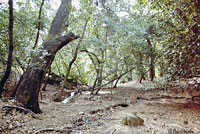 |
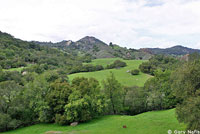 |
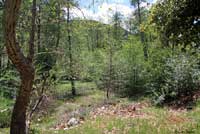 |
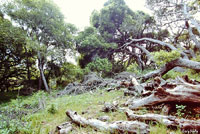 |
||||||||||||||||||||||||||||||||||||||||||||||||
| Habitat, San Luis Obispo County | Habitat, San Luis Obispo County | Habitat, San Gabriel Mountains, Los Angeles County |
Habitat, San Luis Obispo County | ||||||||||||||||||||||||||||||||||||||||||||||||
 |
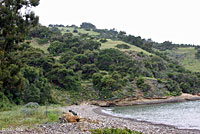 |
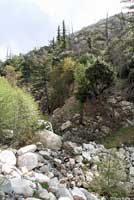 |
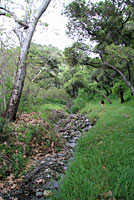 |
||||||||||||||||||||||||||||||||||||||||||||||||
| Habitat, 3,800 ft., San Gabriel Mountains, Los Angeles County | Habitat, Santa Cruz Island | Habitat, 3,800 ft., San Gabriel Mountains, Los Angeles County |
Habitat, 1400 ft., San Gabriel Mountains, Los Angeles County | ||||||||||||||||||||||||||||||||||||||||||||||||
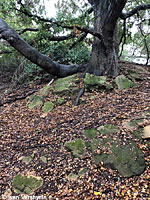 |
|||||||||||||||||||||||||||||||||||||||||||||||||||
| Habitat, Coastal Southern California © Ivan Vershynin |
|||||||||||||||||||||||||||||||||||||||||||||||||||
| Short Video | |||||||||||||||||||||||||||||||||||||||||||||||||||
 |
|||||||||||||||||||||||||||||||||||||||||||||||||||
| Black-bellied Slender Salamanders squirming around in Santa Barbara County | |||||||||||||||||||||||||||||||||||||||||||||||||||
|
|||||||||||||||||||||||||||||||||||||||||||||||||||
|
|||||||||||||||||||||||||||||||||||||||||||||||||||
|
The following conservation status listings for this animal are taken from the July 2025 State of California Special Animals List and the July 2025 Federally Listed Endangered and Threatened Animals of California list (unless indicated otherwise below.) Both lists are produced by multiple agencies every year, and sometimes more than once per year, so the conservation status listing information found below might not be from the most recent lists, but they don't change a great deal from year to year.. To make sure you are seeing the most recent listings, go to this California Department of Fish and Wildlife web page where you can search for and download both lists: https://www.wildlife.ca.gov/Data/CNDDB/Plants-and-Animals. A detailed explanation of the meaning of the status listing symbols can be found at the beginning of the two lists. For quick reference, I have included them on my Special Status Information page. If no status is listed here, the animal is not included on either list. This most likely indicates that there are no serious conservation concerns for the animal. To find out more about an animal's status you can also go to the NatureServe and IUCN websites to check their rankings. Check the current California Department of Fish and Wildlife sport fishing regulations to find out if this animal can be legally pursued and handled or collected with possession of a current fishing license. You can also look at the summary of the sport fishing regulations as they apply only to reptiles and amphibians that has been made for this website. This salamander is not included on the Special Animals List, meaning there are no significant conservation concerns for it in California according to the California Department of Fish and Game. |
||
| Organization | Status Listing | Notes |
| NatureServe Global Ranking | ||
| NatureServe State Ranking | ||
| U.S. Endangered Species Act (ESA) | None | |
| California Endangered Species Act (CESA) | None | |
| California Department of Fish and Wildlife | None | |
| Bureau of Land Management | None | |
| USDA Forest Service | None | |
| IUCN | ||
Return to the Top
© 2000 -

